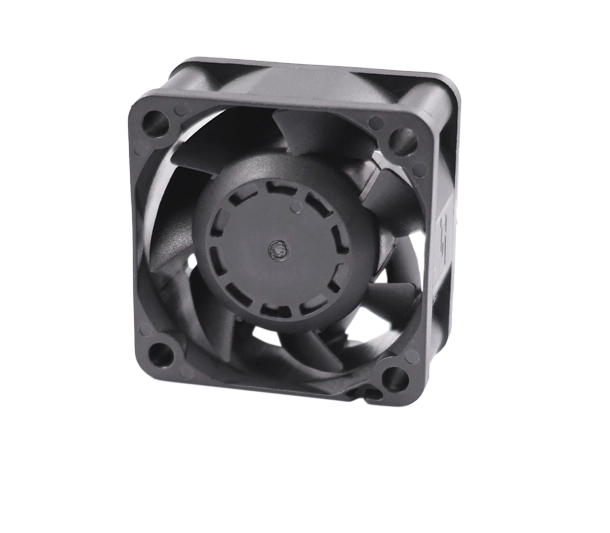As modern industrial and electronic equipment continues to increase in power and density, heat management has become a key factor to ensure equipment stability and extend its service life. The 12VDC axial fan has become an indispensable heat dissipation option for many devices due to its efficient cooling effect, stable performance, low power consumption, and other characteristics. This article Shengjiu will introduce the working principle and structural composition of the 12VDC axial fan in detail.

Working Principle of the 12VDC Axial Fan
The 12VDC axial fan is a cooling device that uses DC voltage to drive the motor. It drives the blades to rotate, forming an axial airflow that transfers heat from inside the device to the outside, thereby achieving a cooling effect. The "12V" in 12VDC refers to the rated voltage of the fan, which is 12 volts direct current (DC), allowing it to operate in low-voltage environments, suitable for efficient and low-noise heat dissipation needs.
When the fan operates, DC current flows through the motor's internal coil to generate a magnetic field. This magnetic field generates a force that interacts with the fan's fixed magnets, driving the blades to rotate along the axis, producing a highly directional airflow. Since the airflow direction is parallel to the axis of rotation, it is referred to as an "axial flow fan." This directional and consistent airflow makes the 12VDC axial fan ideal for producing uniform cooling in confined spaces.
Compared to traditional AC fans, 12VDC axial fans start quickly, generate less noise, and can achieve efficient heat dissipation under low power conditions. By adjusting the voltage, the fan speed can be modified to meet various cooling requirements. For situations requiring precise temperature control, such as data centers, server rooms, and power supply equipment, 12VDC axial fans provide efficient and flexible cooling solutions.
Structure of the 12VDC Axial Fan
The 12VDC axial fan may appear simple, but each component is critical to its overall performance. Its main structure includes:
Blade
The blades are one of the core components of the fan, directly impacting the fan's airflow, pressure, and operating noise. The blades of the 12VDC axial fan are usually made of high-strength plastic or metal materials to ensure strength and stability at high speeds. The number, shape, and angle of the blades are optimized according to specific cooling requirements. Through precise aerodynamic design, the blades can produce stronger airflow and lower noise while reducing friction. For example, a curved blade design can enhance airflow stability and reduce resistance and noise when the blades rotate.
Motor
The motor is the fan's driving force, with most 12VDC axial fans using brushless DC motors. Brushless motors have significant advantages in starting, speed regulation, and operating stability. They adjust the speed through electronic control, reducing mechanical friction and greatly enhancing the fan's lifespan and stability. Brushless motors can maintain stable operation even at high temperatures and are not easily affected by magnetic interference, making them ideal for industrial and electronic equipment that requires continuous cooling. Additionally, the motor allows precise fan speed control by adjusting the voltage, catering to various temperature management needs.
Bracket
The bracket of the 12VDC axial fan supports the fan's blades and motor, ensuring structural stability during high-speed rotation. Typically made of engineering plastic or aluminum alloy, the bracket is both lightweight and durable, with corrosion resistance. Aluminum alloy brackets also offer good thermal conductivity, which aids in dissipating heat around the fan, further improving cooling efficiency. The bracket's design considers airflow smoothness and blade rotation angle, allowing the fan to maintain balance and stability during high-speed operation.
Bearing
Bearings are crucial components that affect the fan's service life and noise level. 12VDC axial fans typically use either ball bearings or liquid bearings. Ball bearings are suitable for high-speed, long-term continuous operation, with low friction and durability, making them ideal for high-performance applications. Liquid bearings, on the other hand, excel in noise reduction, making them suitable for low-noise environments. High-quality bearings significantly reduce friction loss during blade rotation, thereby extending the fan's lifespan, reducing noise and vibration, and effectively lowering the fan's failure rate.
In general, the 12VDC axial fan has become an essential cooling solution in modern industrial and electronic equipment due to its efficient heat dissipation performance, precise structural design, and stable operation. Its working principle and component design demonstrate meticulous optimization for cooling efficiency and longevity—from the aerodynamic design of the blades to the stable operation of the brushless motor, as well as the durability of the bracket and bearings, each component enhances the fan's overall performance and reliability. Compared with traditional AC fans, 12VDC axial fans not only offer advantages in power consumption and noise control but also provide flexible cooling options for different environments. Therefore, whether used in industrial equipment and server rooms with high cooling requirements or in electronic devices with strict noise control, 12VDC axial fans are an ideal heat dissipation choice.
https://www.shengjiuglobal.com/Cooling-Fans/SA4020.html
www.shengjiuglobal.com
Shengjiu Group

